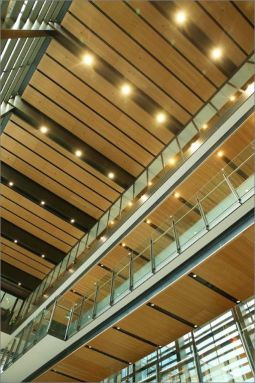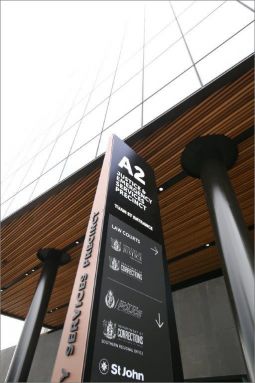A prominent Christchurch lawyer says the new Justice and Emergency Services Precinct is a wonder in design and functionality, but he is concerned about security and safety issues and constitutional separation. And on top of this there’s no hot food in the cafe.
The $300 million Precinct was formally opened in September 2017 by the then Prime Minister Bill English and operations began in October. It brings all regional justice and emergency services together in one facility.

The balustrade within the Precinct
Grant Tyrrell, a partner at Weston Ward and Lascelles and Vice-President of the New Zealand Law Society Canterbury Westland branch, says the main list court is too small having been reduced “by well over half the seats in the public gallery” from the former Courthouse in Durham Street. He says that is resulting in security and space issues.
“The positioning of the counsel bar is close to the public seating area, so you have the public walking through the court behind counsel and you never know where anyone is at any one point.
“For any hearing with significant public interest you can’t split the parties up. So for the first appearance of a murder accused, in the old court there was a natural barrier between people there for the accused and those present for the victim. Whereas all the seating in this place is all on one side,” he says.

The signage outside the new Precinct
He fears the standard-height balustrade on the third floor, where most of the Family Court hearings are held, is not be enough to prevent someone going over.
“The third floor has an open balcony so if someone happened to go over the side it would be rather messy at the atrium below. There has been a bit of an improvement with security with more numbers in that area, but it’s very brave architecture.”
Mr Tyrrell is aware of an incident in the past month where a distressed party came out of court and “launched themselves” in the direction of the balcony edge before a registrar intervened.
“Someone could jump or be thrown off with some ease. That’s quite concerning and it was one of the first things that people brought up when the Courthouse was opened - that it was open and there was quite a drop.”
He also says the non-contact booths are not soundproof, and there’s more distance between the remand cells and the courts “that caught everyone by surprise, we all thought it would be quicker (to get people into the court rooms)”.
‘Advanced approach to seismic design’
Fraser Gibbs, General Manager Commercial and Property at the Ministry of Justice, says the Precinct was designed to conform to safety guidelines.
“The Precinct was built according to the building code and was constructed using an advanced approach to seismic design, including base isolation. The balustrades in the Precinct exceed the requirements of the building code and are 1.4m rather than 1.1m high.
“The courtrooms are designed to be used by a number of different jurisdictions, from the High and District Court, through to specialist courts and tribunals, and are similar to courtrooms throughout New Zealand.”
Good stuff
Mr Tyrrell says, despite the ongoing issues, there is an awful lot to be proud of the new Precinct.
“There is a great deal of good stuff about the new building – there’s an excellent lawyers’ room, good wi-fi, and the library is a fantastic space which the staff should be feted for. There’s not the same downtime there used to be, so if you’ve got a case that’s been stood down, there’s always a meeting room where you can perch in rather than lose time, it’s a lot nicer to go to, and the atrium cafe is good.”
However, security concerns mean Mr Tyrrell is deprived of one of his favourite foods.
“Ironically, there is no toastie pie machine in the cafe in case someone gets hurt. The only hot thing they can serve is coffee so there’s no pies or warm croissants as they can’t have a microwave or a toastie machine, which is a shame because I quite like toastie pies.”
Blurring of constitutional separation
“To my mind the biggest issue is the blurring of the constitutional separation between the enforcement of justice and the administration of it. The Ministry just doesn’t seem to have the slightest concept of constitutional separation.
“From the outside the only real emblems are those of the Police. One of the first things that should be done is for the Courthouse to be named as such. There’s nothing distinctly suggesting that the courts are separate from the police, and that needs to be encouraged.”
But Mr Gibbs says efforts have made to direct people where they need to be.
“As a part of the Precinct project, considerable emphasis has been placed on signage to help visitors navigate both the exterior and interior of the facility. Both exterior and interior signs direct visitors to ‘The Law Courts’ or ‘courtrooms’,” he says.
But despite his misgivings, Grant Tyrrell feels the centre is serving justice with aplomb.
“I have talked more about the negatives than the positives, but that’s a little unfair because the positives are right up there. But of course you don’t get things fixed by saying ‘everything is good’.”
He gives a eight out of 10 for the facilities, a 10 for the staff, “it’s really only through the hard work of court staff that it’s even got up and running at the time it did” – but for consitutional separation he gives just one point.
“It’s a quantum leap above what we had before.”
Court of Appeal President Stephen Kós, speaking after the Court of Appeal sat in the Precinct for the first time, said: “The precinct is a magnificent achievement but it is one I hope we never repeat. I think, every day in small towns around the country we give school children a lesson in civics when they walk down the street and see the police on one side of the road and the court house on the other.
“It is symbolic of the functional disconnection between the branches of government. It is an important lesson.”
